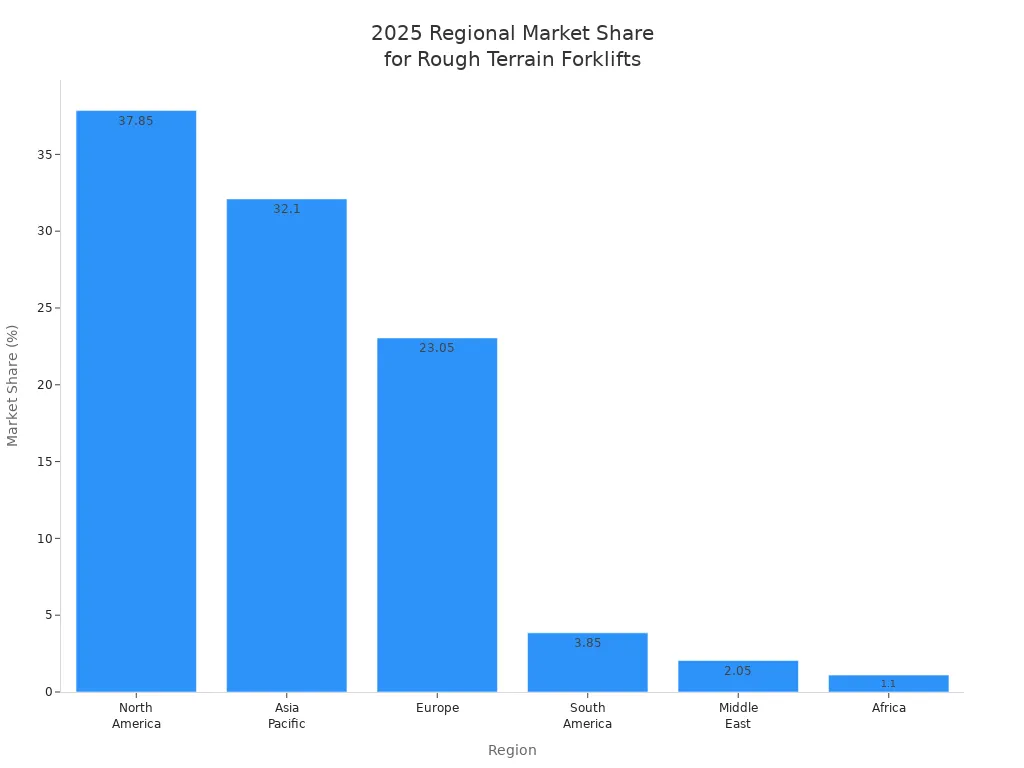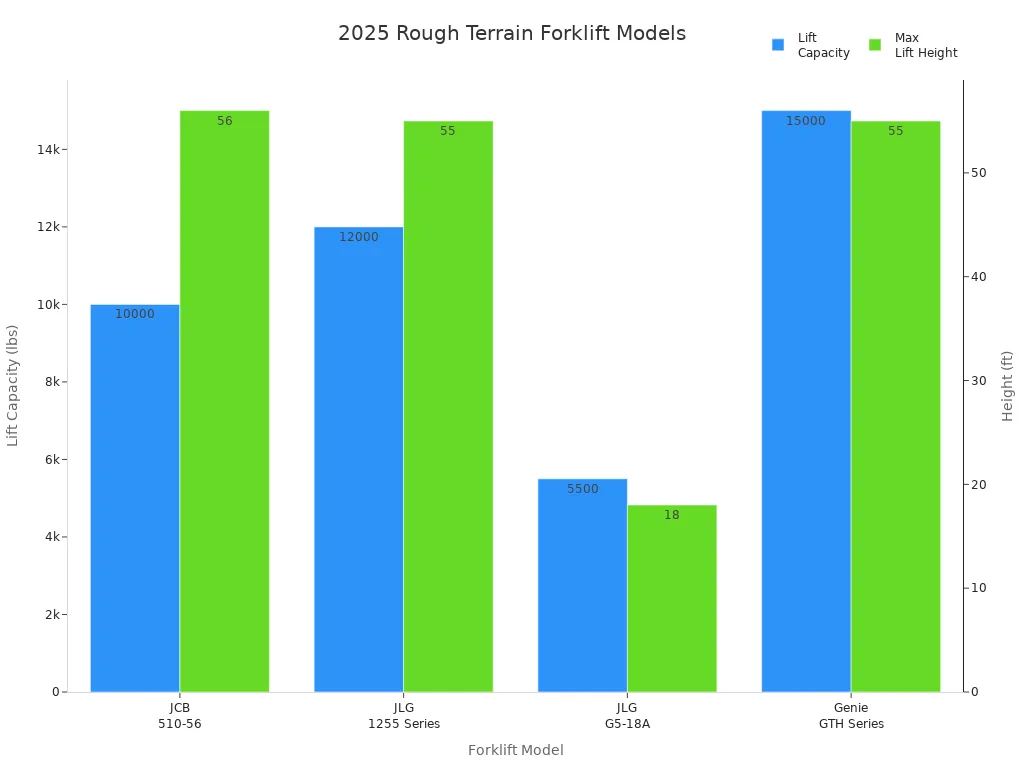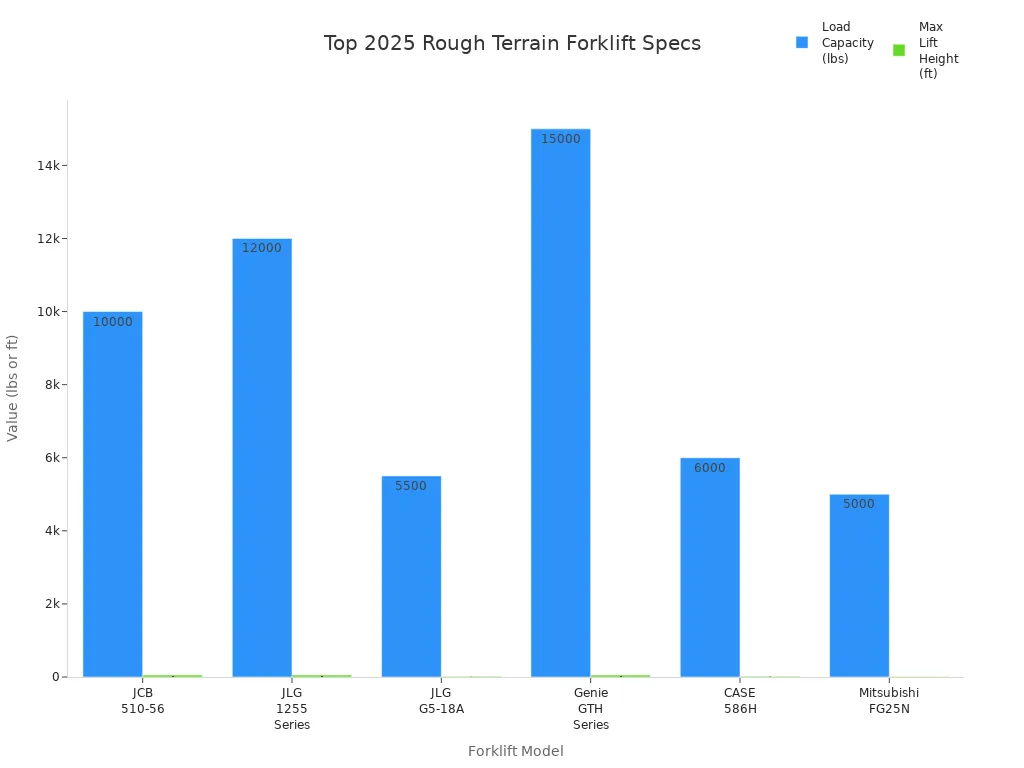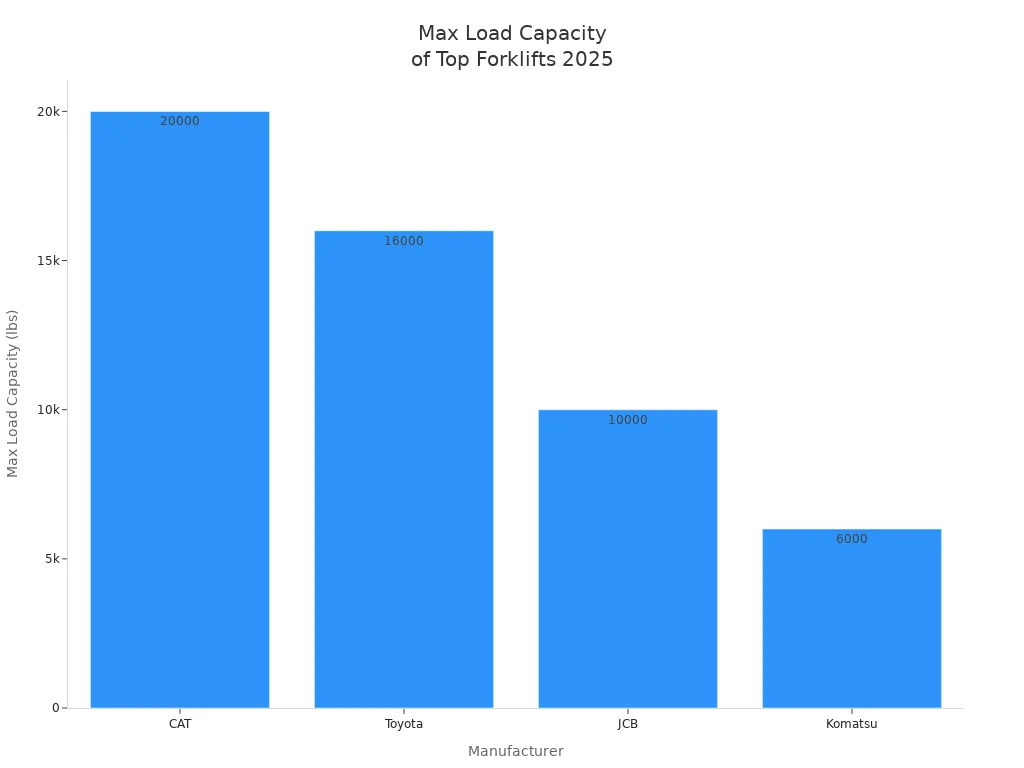AUGUST 22, 2025
Comparing top rough terrain forklift brands and models in 2025

Hyster-Yale, Komatsu, Toyota, and Doosan are top brands for rough terrain forklifts in 2025. These brands work well in building, wood, and outdoor jobs. Their models are known for being tough and safe. The chart below shows North America and Asia Pacific have the biggest market share.

Buyers should look at features. They should think about the job site, ground type, and cost to pick the best one.
Key Takeaways
The best rough terrain forklift brands in 2025 are Caterpillar, Toyota, Manitou, Komatsu, and Bobcat. These brands are strong, safe, and have new features.
Important forklift features are engine power, lift capacity, terrain adaptability, and safety systems. Safety systems include stability control and ergonomic cabs.
You pick 2WD or 4WD based on your job site. 4WD works better on rough ground but uses more fuel. 2WD saves fuel and does not wear out as fast.
New forklifts have better technology, safety, and last longer. But they cost more money. Used forklifts cost less but may need more repairs.
Buyers should choose forklifts that fit their work, ground type, and budget. This helps keep people safe, work fast, and save money over time.
Top Rough Terrain Forklift Brands
Leading Manufacturers
Many companies are top choices for rough terrain forklift equipment in 2025. These brands have good reputations for making machines that work well outside.
Caterpillar (Cat Lift Trucks) makes forklifts that can handle tough places. Their machines last a long time and have strong safety features.
JCB builds forklifts with new technology for building and farming.
Manitou Group is known for rough-terrain material handling. Their forklifts are used on farms and building sites around the world.
Toyota is known for fuel efficiency and being reliable. The company helps customers everywhere.
Hyster-Yale makes forklifts that work well in many jobs.
BOBCAT has machines that can do many outdoor tasks.
SkyTrak is a favorite for telehandlers and rough terrain models.
Liftking makes strong forklifts for heavy lifting.
Crown, Mitsubishi Logisnext, Jungheinrich, and Clark also have good choices for rough terrain work.
Komatsu and Doosan design forklifts for hard jobs. They use new technology and care about operator comfort.
Many of these brands make Class 7 forklifts. These machines use diesel engines and have pneumatic tires. This makes them great for rough ground and outdoor jobs.
Market Position in 2025
Companies try to win more customers by adding new features and giving good support. The best brands sell more forklifts and keep buyers happy.
Brands like Caterpillar, Toyota, and Manitou are leaders because their machines are tough and a good deal.
Market position depends on what type of forklift, how much it can lift, and where it is used.
Forklifts come in vertical mast, telescopic, and rotational types.
Power can be diesel, electric, or hybrid.
Top brands work in construction, mining, farming, and factories.
Growth in these areas helps brands get more customers.
| Brand | Strengths | Main Sectors |
|---|---|---|
| Caterpillar | Durability, safety | Construction, Mining |
| Toyota | Reliability, efficiency | All sectors |
| Manitou | Specialization, versatility | Agriculture, Building |
| Komatsu | Technology, sustainability | Industrial, Mining |
| Hyundai | Value, innovation | Construction, Lumber |
CAT and Mitsubishi are picked for being very strong. Toyota is good because it is reliable and saves fuel. Hyundai gives good value for less money. These brands help buyers choose the right rough terrain forklift for their work.
Notable Rough Terrain Forklift Models
Top Picks for 2025
In 2025, companies made some great new models. These machines help workers lift heavy things on bumpy ground. Each one is good for building, farming, or factory work.
| Model | Engine Type | Lift Capacity | Max Lift Height | Standout Feature |
|---|---|---|---|---|
| BOBCAT V923 VersaHANDLER | 130 hp turbocharged diesel | 9,000 lbs | 23 ft | Advanced boom positioning, superior visibility |
| JCB 510-56 Telehandler | 109 hp EcoMax Tier 4 Final | 10,000 lbs | 56 ft | Extended reach, stable operation |
| Manitou M50-4 | 74 hp diesel | 11,000 lbs | N/A | High ground clearance, ergonomic cab |
| Caterpillar TL943 | 99 hp Cat® C3.4B | 9,000 lbs | 43 ft | Load-sensing hydraulics, energy efficiency |
| SkyTrak 10054 | Cummins Tier 4 Final | 10,000 lbs | 54 ft | Stabil-Trak rear axle stabilization |
| Toyota Electric Pneumatic | Lithium-ion battery | 8,000-17,500 lbs | N/A | Electric drive, power and efficiency |
| Viper FY35 Forklift | LP gas engine | 8,000 lbs | N/A | Pneumatic tires, rough terrain capability |
| Liftking Rough Terrain Series | Diesel | 10,000+ lbs | N/A | Heavy-duty frame, versatility |
Many people like the JCB 510-56 Telehandler because it can reach high and lifts steady. The BOBCAT V923 VersaHANDLER is special for its boom and clear view. Manitou M50-4 has lots of space under it, so it works well on muddy or rocky ground. Caterpillar TL943 saves energy with smart hydraulics. SkyTrak 10054 keeps things balanced with its back axle. Toyota’s electric models are strong and use batteries that last long.

Key Features
The best models in 2025 have new engines, tough frames, and smart controls. These things help workers stay safe and finish jobs faster.
Engine Power: Most forklifts use diesel engines with lots of horsepower. Toyota has electric drive with lithium-ion batteries for clean energy.
Lift Capacity: Some machines, like Genie GTH Series, can lift up to 15,000 pounds. JLG 1255 Series lifts 12,000 pounds. Many can lift more than 8,000 pounds, which is good for heavy stuff.
Max Lift Height: JCB 510-56 Telehandler can go up to 56 feet. SkyTrak 10054 can lift to 54 feet. These heights help workers put things on tall buildings.
Drive and Control: Four-wheel drive and joystick controls are in many models. These make steering simple and easy.
Terrain Adaptability: Pneumatic tires and high ground clearance help forklifts move over rocks and mud. Liftking and Manitou focus on these things.
Safety Systems: Stabilization systems, like SkyTrak’s Stabil-Trak, keep loads steady. Ergonomic cabs help drivers not get tired.
| Model | Load Capacity (lbs) | Max Lift Height (ft) | Engine Type | Drive/Steering Features | Control System |
|---|---|---|---|---|---|
| JCB 510-56 | 10,000 | 56 | Tier 4 Final JCB EcoMAX | Precision single lever joystick | Telescopic handler |
| JLG 1255 Series | 12,000 | 55 | Diesel | 4-wheel drive | Precision joystick |
| Genie GTH Series | 15,000 | 55 | Diesel | 4-wheel drive and steering | Multi-function joystick |
| Toyota Electric Pneumatic | 8,000-17,500 | N/A | Lithium-ion battery | Electric drive | Advanced controls |
| Viper FY35 | 8,000 | N/A | LP gas | Pneumatic tires | Standard controls |

People want forklifts with strong engines, high lift, and easy controls. These features help rough terrain forklift machines do well on building sites, farms, and outdoor jobs.
Brand Overviews
Caterpillar
Caterpillar makes strong machines that last a long time. Their forklifts work well outside in tough places. Many models have smart hydraulics and engines that save energy. Operators like the safe features and comfy cabs. Caterpillar has many dealers and lots of spare parts.
JCB
JCB is famous for new ideas in building and farming. Their telehandlers and forklifts use new tech for better work. JCB machines can lift high and have strong engines. The company cares about comfort and easy controls. Many job sites pick JCB because it is trusted and helpful.
Manitou
Manitou’s 2025 models have many new things:
M30-4 and M40-4 use 4-wheel drive and big tires for rough ground.
They can go over rocks and mud with up to 16 inches of space under them.
Drivers can choose duplex or triplex masts, reaching up to 26 feet.
The mast tilts forward 42 degrees and back 12 degrees.
Basic models have open cabs with ROPS, but buyers can add doors, heaters, or radios.
Some small models have 11.8-inch ground clearance and a glass roof.
Drivers can switch between two-wheel and four-wheel drive from inside.
They use only 0.92 gallons of fuel per hour and are not loud at 79 decibels.
These forklifts need 20% less maintenance than old ones.
They can go as fast as 15.2 mph, and buyers can pick different motors.
Manitou wants their machines to be flexible, safe, and cheap to run.
Toyota
Toyota makes forklifts that are strong and save energy. Many models use electric power with lithium-ion batteries. These forklifts help companies use less fuel and make less pollution. Toyota forklifts work in many jobs. The company gives good help and easy repairs.
Hyster-Yale
Hyster-Yale builds forklifts for rough and bumpy ground. Their machines work where roads are bad or weather changes. Models can lift from 1800 to 5000 kg and have strong engines for hard work. The company cares about safety and helps with repairs and fleet care. Hyster-Yale wants their forklifts to be tough and flexible.
BOBCAT
Bobcat is known for easy repairs and service. Rental companies like Bobcat because they can fix them fast. Bobcat telehandlers are good for many jobs, and drivers feel safe and comfy. The brand is trusted and has many choices. Bobcat uses green tech and digital tools, but its main strength is simple design.
SkyTrak
SkyTrak’s 2025 models, like the 8042 telehandler, can lift 8,000 pounds and reach 42 feet high. Operators use forks and buckets for different jobs. The cab is comfy, and controls are simple. The 110-horsepower engine and smart hydraulics make work fast and smooth. Safety features include ROPS, FOPS, and StabiliTrak™. Four-wheel drive and a moving back axle help SkyTrak go over rough ground.
Liftking
Liftking has made forklifts for over 50 years. The company checks quality and builds everything itself. Military-level safety and strong features come with every model. They can lift from 5,000 to 65,000 pounds for big jobs. Liftking forklifts have high ground clearance, tough tires, and strong hydraulics. Drivers get comfy cabins and smart controls for safety. Liftking works in building, farming, and mining all over the world.
Other Brands
| Brand | Unique Strengths and Market Focus |
|---|---|
| Merlo | Small telehandlers for farms; easy to move in tight spots |
| Claas | Used on farms; works with other farm machines |
| Dieci | Telehandlers for building and farms; strong and reliable |
| Wacker Neuson | Small machines; good for small businesses and many uses |
| Liebherr | Big machines; new ideas and safety; lifts heavy things |
| Skjack | Cheaper models; still good quality; good for saving money |
| Haulotte | Good at safe lifting with smart engineering |
Many of these brands focus on special jobs, like farming or saving money. They help buyers pick the best machine for what they need.
Rough Terrain Forklift Features
Engine Power
Engine power is very important for rough terrain forklifts. Different engines are used for different jobs. Some forklifts use diesel, gasoline, LPG, or electric engines. Many 2025 models, like the Manitou MC 25-4 and MC 30-4, have Kubota engines. These engines help forklifts work inside and outside. Operators see better fuel use and comfort. The table shows engine types and models in top forklifts:
| Model | Engine Type | Engine Model | Power Output (hp/kW) | Notes |
|---|---|---|---|---|
| JCB 930 | Diesel | JCB ECOMAX TCAE-55 | N/A | Heavy-duty diesel engine |
| CASE 586H | Diesel | FPT F5HFL,463D | N/A | 6,000 lb capacity |
| JLG G5-18A | Diesel | Deutz TD 2.9 L4 | N/A | Compact telehandler, 5,500 lb |
| Mitsubishi FG25N | Dual fuel (Gasoline/LPG) | GK21E | N/A | 5,000 lb capacity |
New engines focus on power, saving fuel, and less pollution. Operators can pick 2WD or 4WD for better control.
Load Capacity
Load capacity means how much weight a forklift can lift. In 2025, CAT has models that lift over 20,000 pounds. Toyota forklifts can lift more than 16,000 pounds. JCB models lift about 10,000 pounds and reach up to 22 feet. Manitou makes small machines with lower lift heights. Komatsu builds smaller forklifts for tight spaces. The table compares top brands:
| Manufacturer | Load Capacity Range | Lift Height | Notes |
|---|---|---|---|
| CAT | Over 20,000 lbs (10+ tons) | N/A | Highest max load, built for power |
| Toyota | Over 16,000 lbs (8+ tons) | N/A | High capacity, narrower model range |
| JCB | Around 10,000 lbs | 15-22 feet | Versatile, high lift heights |
| Manitou | Not specified, ≤10 feet | ≤10 feet | Compact, high ground clearance |
| Komatsu | 2,000 to 6,000 lbs | N/A | Smaller, suited for compact sites |

2WD vs 4WD
Operators pick 2WD or 4WD for each job. Both have good and bad points:
4WD helps on mud, gravel, or snow.
Using 4WD on hard ground wears out front parts faster.
4WD uses more fuel than 2WD because it works harder.
Manuals say use 4WD only when needed, like for towing or engine braking.
Drivers use 2WD to save fuel and stop extra wear.
| Advantage Category | Explanation |
|---|---|
| Power and Agility | 2WD forklifts are lighter and turn fast on bumpy ground. |
| Cost-Effectiveness | 2WD models cost less and still meet rules for quality and emissions. |
| Design for Rough Terrain | Wide chassis and high ground clearance make them safer and more stable on rough ground. |
| Compact Footprint | Small size helps in tight places, good for farms and building sites. |
Terrain Adaptability
Terrain adaptability means how well a forklift moves on different ground. Pneumatic tires and high ground clearance help forklifts go over rocks, mud, and sand. Many models let you pick 2WD or 4WD. Operators use these features to stay safe on slopes or rough ground. Wide chassis and special tires keep forklifts steady. These forklifts work well on farms, building sites, and outside jobs.
Tip: Operators should look at the ground before picking a forklift. The right features help stop accidents and keep work going.
Performance and Value Comparison
Durability
Rough terrain forklifts are made to last in tough places. They have strong frames and heavy parts to stop breakdowns. Wide wheelbases and low centers of gravity help keep them from tipping over. Big tires with deep treads and thick rubber give better grip and soak up bumps. High chassis keep the forklift safe from rocks and trash. Drivers like comfy cabins and smart transmissions that make work easier and help the forklift last longer.
Strong frames and parts mean less money spent on fixing.
Wide wheelbases and four-wheel drive help keep forklifts steady.
Special tires give better grip and a smoother ride.
High ground clearance lets forklifts move safely on bumpy ground.
Drivers who pick strong forklifts fix them less and work more.
Technology and Safety
In 2025, rough terrain forklifts have new tech for safety and better work. Makers add AI-powered Pedestrian Proximity Detection systems. These use cameras and sensors to spot people and warn drivers or stop the forklift. Video cameras record what happens for safety checks later. Digital checklists, speed limits, and event logs help stop accidents.
System of Active Stability (SAS) keeps forklifts from tipping.
Operator Presence Sensing System (OPSS) turns off controls if the driver leaves.
Clear-view masts and extra lights help drivers see better.
Active Mast Control (AMC) changes mast angle for balance.
Smart Environment Sensor (SEnS) and SEnS+ find people and things, then warn or stop the forklift.
Adjustable seats and anti-vibration tech make driving easier.
LED lights and alarms warn people nearby.
Electric power with lithium-ion batteries lasts longer and charges fast.
Some forklifts can drive themselves or help drivers more.
IoT tracks forklift use, loads, and when to fix them.
Green tech like hydrogen fuel cells refuel fast and make less pollution.
New tech helps drivers stay safe and finish jobs faster. Safety systems protect people and machines.
Cost and Value
People look at price and value before buying a rough terrain forklift. New forklifts cost $13,700 to $47,565. Used ones cost $6,300 to $13,650. Bigger lift and more features make forklifts cost more. New forklifts may cost extra for custom parts, safety tech, warranties, and delivery. These extras can add 10–25% to the price. Used forklifts are cheaper but might break more.
| Model | Lift Capacity (lbs) | Engine Type | Estimated Cost Range (Used/New) |
|---|---|---|---|
| Caterpillar TH255C | 25,500 | Four-cylinder diesel | $8,925 – $28,350 |
| JCB 930 | 19,000 | Four-cylinder diesel | $6,825 – $29,400 |
| John Deere CT5539 | 39,000 | Six-cylinder diesel | $7,350 – $33,600 |
| Toyota 7FD25 | 25,000 | Four-cylinder diesel | $6,300 – $19,950 |
| Komatsu FG25ST-16 | 25,000 | Four-cylinder diesel | $8,400 – $47,250 |

Some new rough terrain forklifts cost $100,000 or more if they are big or have lots of features. Most four-wheel models cost $30,000 to $65,000. Used forklifts are 25% to 50% cheaper than new ones. Companies must think about the first price and how much it costs to keep the forklift running.
New forklifts have better tech and are safer.
Used forklifts cost less but might need more fixing.
Custom parts and safety tech make forklifts better but cost more.
Long-term value depends on how long the forklift lasts, how much it costs to fix, and if it can be sold later.
Buyers should think about both the first price and long-term value when picking a forklift.
Choosing the Right Rough Terrain Forklift
Assessing Business Needs
Companies need to think about their work before picking a rough terrain forklift. They should decide if the forklift will be used inside, outside, or both. It is important to know how heavy the loads are and how high they need to go. Businesses must check if the aisles are wide enough for the forklift. They also need to know how many hours the forklift will be used each day. Maintenance is something to think about too. Operators must know the load center because longer loads make lifting harder. The size of the forklift and how high it can lift should fit the space and storage.
Tip: Companies that pick forklifts with the right features for their jobs have fewer accidents and get more work done.
Matching to Terrain
The place where the forklift will work helps decide which one to buy. Outdoor areas with bumpy ground need forklifts with big, tough tires and lots of ground clearance. Diesel or LPG forklifts are good for outside jobs. Electric forklifts are better for inside because they are quiet and do not make smoke. Safety features like stability systems, guards, and cameras help keep workers safe on rough ground.
| Factor | Explanation |
|---|---|
| Operating Environment | Outdoor jobs need strong tires and high clearance; indoor jobs are better with electric models. |
| Forklift Type | Rough terrain forklifts have special tires and clearance for bumpy ground. |
| Safety Features | Stability systems, cameras, and comfy design keep workers safe. |
Budget Considerations
How much money a company has changes what forklift they can buy. New rough terrain forklifts with air-filled tires cost from $77,000 to $125,000 if they can lift more. Used forklifts cost less, from $24,000 to $91,000. Smaller used forklifts start at $11,500. Companies should think about the price, fuel, repairs, and time when the forklift cannot be used. Buying from trusted sellers who give service plans can help save money over time.
| Capacity (lbs) | New Price Range | Used Price Range |
|---|---|---|
| 10,000 | $77,000 - $80,000 | $24,000 - $55,900 |
| 15,000 | $105,000 - $125,000 | $43,000 - $91,000 |
New vs Used
Picking new or used forklifts depends on what the business needs and how much money they have. New forklifts are more reliable, have better safety, and come with long warranties. They cost more at first but last longer and break less. Used forklifts are cheaper and you can get them fast. But they might not have the newest safety and may need more repairs.
| Aspect | New Forklifts - Pros | New Forklifts - Cons | Used Forklifts - Pros | Used Forklifts - Cons |
|---|---|---|---|---|
| Cost | Good value over time | Costs more at first | Cheaper to buy | More repairs needed |
| Reliability | Breaks less, lasts longer | Loses value | Ready to use right away | May stop working more often |
| Warranty | Long coverage | N/A | Short or no warranty | Not much warranty |
| Safety | Newest safety features | N/A | Might have extras | Older safety features |
Note: Companies that use forklifts every day for hard work often buy new ones. Companies that use forklifts only sometimes can save money by buying used ones.
Top brands like Toyota, Hyster, Komatsu, and Yale are known for being reliable. They have good safety features and work well inside and outside.
Toyota has many models and some use electricity. These electric forklifts are quiet and save energy.
Hyster and Komatsu make strong machines for hard jobs. They help drivers with special systems.
Yale builds forklifts that are comfortable and safe for warehouse work.
Buyers should pick a forklift that fits their job. They need to think about how much it can lift and what features it has. Talking to dealers, trying out forklifts, and looking at support after buying helps keep work safe and smart.
FAQ
What makes a forklift suitable for rough terrain?
A forklift needs tough tires and lots of space under it. It should have a strong engine to move heavy things. Four-wheel drive helps it go over rocks, mud, or sand. Safety features keep the driver safe outside.
How often should operators service rough terrain forklifts?
Operators should look over the forklift before every shift. Most brands say to do a full service after 250 hours of use. Regular care keeps the forklift safe and working right.
Which fuel type works best for outdoor forklift jobs?
Diesel engines are strong and last long outside. Electric forklifts are better for inside jobs. LPG gives good power and makes less pollution.
Can rough terrain forklifts work in snow or rain?
Yes, most rough terrain forklifts have cabins that block bad weather. They also have special tires for slippery ground. Drivers should go slow and use safety systems. Wet or icy ground needs extra care.
How does load capacity affect forklift choice?
Operators must pick a forklift that can lift their heaviest load. Lifting too much can break the forklift and cause accidents. Always check the maker’s rating before lifting.













 English
English 


